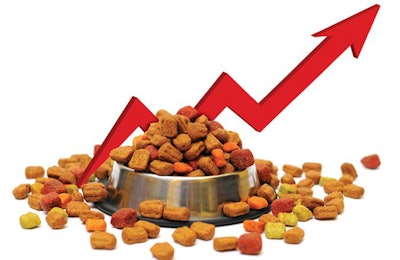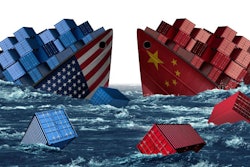
U.S. pet owners spent US$30.32 billion on pet food in 2018, according to the latest annual pet industry spending report released by the American Pet Products Association during Global Pet Expo 2019. That represented a 4.3% increase over 2017 pet food spending, a healthy year-over-year rise. Yet if you adjust the figure for inflation, how much of that growth was a true spending increase?
All of it, if not slightly more, said John Gibbons on his blog, the Pet Business Professor. Looking at what he called “petflation,” or changes in the Consumer Price Index (CPI) as determined by the U.S. Bureau of Labor Statistics, he found that pet food prices remained low in 2018, nearly deflationary at a -0.02% decline. When he applied that to 2018 U.S. pet food spending, he concluded that 100.5% of the increase over 2017’s U.S.$29.07 billion in spending was real.
Pet food’s record run: lower prices, higher spending
Gibbons also looked back 10 years at changes in both pet food spending and CPI, from 2009 to today. After 2013, he remarked, pet food pricing in the U.S. became and has remained deflationary, including a record -1.1% drop in 2017. In a category like pet food that consumers need to buy (yet buy only as much as their pets need), this would typically lead to lower sales. “You don’t buy more pet food because it is cheaper. However, this occurred at the same time as the introduction of superpremium foods,” Gibbons wrote. “This has produced the unusual situation of growing retail food sales despite extraordinarily strong deflation.”
The result? From 2009 to 2018, U.S. pet food spending has increased at an annual average rate of 6.26%. Cumulatively, that means a 72.7% rise over those nine years, or an additional US$12.76 billion. Adjusted for inflation – or, in this case, mainly deflation – 91.3% of the pet food spending increase since 2009 has been real growth.
Is pet food deflation healthy in the long run?
While the U.S. pet food market has been enjoying this run, it may not be the best for the long term, according to Gibbons. “The pet food market is the most competitive in history. Manufacturers, retailers and whole retail channels, including the internet, are now actively engaged in a furious battle for consumers’ pet food dollars,” he wrote. “This price war is initially great for consumers and has allowed a much deeper demographic penetration of superpremium pet foods. However, it is putting increased profit pressure on the supply and distribution channels. This could be bad for all, including the consumer, through reduced choices.”
Gibbons speculated that prices may have bottomed out in 2018. “A reasonable inflation rate, perhaps 1%, might be best for the future,” he concluded.
Even better? A follow-up to superpremium, the so-called “next big thing” in pet food. Or as Gibbons put it: “It’s time for yet another new, ‘must have’ upgrade in pet food to keep consumer spending moving up.”

















